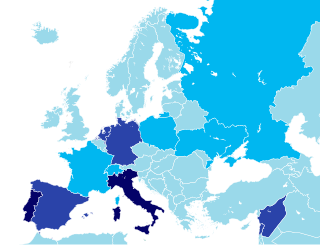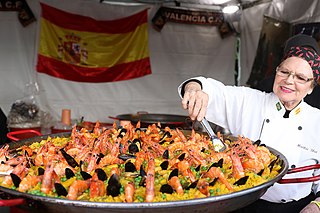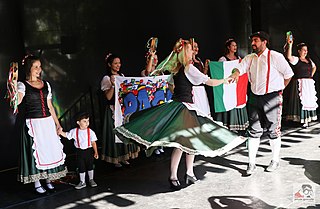
Japanese Brazilians are Brazilian citizens who are nationals or naturals of Japanese ancestry or Japanese immigrants living in Brazil or Japanese people of Brazilian ancestry.
This article details the geographical distribution of speakers of the German language, regardless of the legislative status within the countries where it is spoken. In addition to the Germanosphere in Europe, German-speaking minorities are present in many other countries and on all six inhabited continents.

Immigration to Brazil is the movement to Brazil of foreign peoples to reside permanently. It should not be confused with the forcible bringing of people from Africa as slaves. Latin Europe accounted for four-fifths of the arrivals. This engendered a strikingly multicultural society. Yet over a few generations, Brazil absorbed these new populations in a manner that resembles the experience of the rest of the New World.

Spanish Brazilians are Brazilians of full or partial Spanish ancestry.

Bento Gonçalves is a municipality located in the state of Rio Grande do Sul, Brazil. Created in 1875, it is one of the centers of the Italian immigration in Brazil. It is also known as the 'wine capital of Brazil' due to its vineyards and wine production. In 2020, its estimated population was 121,803 inhabitants.

The Italian diaspora is the large-scale emigration of Italians from Italy. There were two major Italian diasporas in Italian history. The first diaspora began around 1880, two decades after the Unification of Italy, and ended in the 1920s to the early 1940s with the rise of Fascist Italy. Poverty was the main reason for emigration, specifically the lack of land as mezzadria sharecropping flourished in Italy, especially in the South, and property became subdivided over generations. Especially in Southern Italy, conditions were harsh. From the 1860s to the 1950s, Italy was still a largely rural society with many small towns and cities having almost no modern industry and in which land management practices, especially in the South and the Northeast, did not easily convince farmers to stay on the land and to work the soil.

Portuguese Brazilians are Brazilian citizens whose ancestry originates wholly or partly in Portugal. Most of the Portuguese who arrived throughout the centuries in Brazil sought economic opportunities. Although present since the onset of the colonization, Portuguese people began migrating to Brazil in larger numbers and without state support in the 18th century.
The Croatian diaspora consists of communities of ethnic Croats and/or Croatian citizens living outside Croatia. Estimates on its size are only approximate because of incomplete statistical records and naturalization, but (highest) estimates suggest that the Croatian diaspora numbers between a third and a half of the total number of Croats.
White Latin Americans or European Latin Americans are Latin Americans of European descent.
Immigration to Chile has contributed to the demographics and the history of this South American nation. Chile is a country whose inhabitants are mainly of Iberian, mostly of Andalusian and Basque origin, and Native American, mostly descended from Mapuche peoples. A moderate numbers of European immigrants settled in Chile during the 19th and 20th centuries, mainly Spanish, as well as Germans, British, French, Southern Slavs, and Italians who have made additional contributions to the racial complex of Chile. However, this immigration was never in a large scale, contrasting with mass migrations that characterized Argentina, Uruguay and southern Brazil, and therefore, anthropologically, its impact with lesser consequence. At the same time, some separate cultural aspects, such as German cakes, British afternoon tea, and Italian pasta, were preserved. The fusion is also visible in the architecture of Chilean cities. This intermarriage and mixture of cultures and races have shaped the present society and culture of Chile.

Friulians, also called Friulans or Furlans, are an ethnolinguistic minority living primarily in Italy, with a significant diaspora community.

Brazil had an official resident population of 203 million in 2022, according to IBGE. Brazil is the seventh most populous country in the world, and the second most populous in the Americas and Western Hemisphere.

Croatian Argentines are Argentine citizens of Croatian descent or Croatian-born people who reside in Argentina. Croats and their descendants settled in Buenos Aires, the homonymous province, Santa Fe, Córdoba, Chaco, and Patagonia. Argentines of Croatian descent number over 250,000.
Croatian Chileans are Chileans of full or partial Croatian descent. Chile has one of the largest communities of ethnic Croats outside Europe, second only to Croatian Americans. They are one of the main examples of successful assimilation of a non-Spanish-speaking European ethnic group into Chilean society. Many successful entrepreneurs, scientists and artists, as well as prominent politicians who have held some of the highest offices in the country, have been of Croatian descent – including the current president of the Republic, Gabriel Boric.
Spanish emigration peaked in the late 19th and early 20th centuries, and it was concentrated to Argentina, Uruguay and Cuba. Between 1882 and 1930, 3,297,312 Spaniards emigrated, of whom 1,594,622 went to Argentina and 1,118,960 went to Cuba. Brazil only started to be an important destination for immigrants from Spain in the 1880s, but the country received the third largest number of Spanish emigrants, behind only the two aforementioned countries. Spaniards also made up the third largest national group to immigrate to Brazil, after the Italians and Portuguese.

The Spanish diaspora consists of Spanish people and their descendants who emigrated from Spain. In the Americas, the term may refer to those of Spanish nationality living there; "Hispanic" is usually a more appropriate term to describe the general Spanish-speaking populations of the Americas together with those in Spain. The diaspora is concentrated in places that were part of the Spanish Empire. Countries with sizeable populations are Argentina, Bolivia, Chile, Colombia, Costa Rica, Cuba, Dominican Republic, Ecuador, El Salvador, Guatemala, Honduras, Mexico, Nicaragua, Panama, Paraguay, Peru, Uruguay, Venezuela, and, to a lesser extent, Brazil, Belize, Haiti, United States, Canada, the Philippines and the rest of Europe.

Italian Brazilians are Brazilians of full or partial Italian descent, whose ancestors were Italians who emigrated to Brazil during the Italian diaspora, or more recent Italian-born people who've settled in Brazil. Italian Brazilians are the largest number of people with full or partial Italian ancestry outside Italy, with São Paulo being the most populous city with Italian ancestry in the world. Nowadays, it is possible to find millions of descendants of Italians, from the southeastern state of Minas Gerais to the southernmost state of Rio Grande do Sul, with the majority living in São Paulo state. Small southern Brazilian towns, such as Nova Veneza, have as much as 95% of their population of Italian descent.

Romanian Brazilians are Brazilians of full, partial, or predominantly Romanian descent, or Romanian-born people residing in Brazil. According to 2008 estimates, there are around 200,000 Romanians or people of Romanian descent currently living in Brazil, although the Ministry of Foreign Affairs of Romania says there only are 7,393 Romanian citizens in Brazil and up to 40,000 Brazilians with some Romanian ancestry.
European immigration to the Americas was one of the largest migratory movements in human history. Between the years 1492 and 1930, more than 60 million Europeans immigrated to the American continent. Between 1492 and 1820, approximately 2.6 million Europeans immigrated to the Americas, of whom just under 50% were British, 40% were Spanish or Portuguese, 6% were Swiss or German, and 5% were French.













